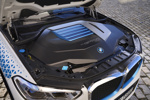Police fleets get a warning on health and safety
POLICE fleets still have a long way to go when it comes to driver health and safety due to lack of co-ordination between departments.
That was one of the over-riding messages from this year’s National Association of Police Fleet Managers conference, hosted by Wiltshire police in Swindon.
A straw poll conducted at the event by one of the speakers, fleet safety expert Dr Will Murray, research director of Interactive Systems, revealed that less than a third (28%) had safety policies in place for drivers.
He said: ‘I’m surprised and disappointed to see that so few have introduced such policies. Only five of 90 delegates present said their policies were revised and updated on an annual basis and only two said they checked to see if drivers properly understood the policy.
‘A minimum starting point for the management of occupational road risk is having a policy in place that everyone understands. Many haven’t even got to that stage. A lot of this is down to the fact that most of the people in this room are responsible for managing vehicles, not drivers. There clearly needs to be more integration within many police forces, so that everyone responsible for controlling drivers out on the road can agree on a policy. Some of the traditional boundaries and empires within organisations may need to be broken down.’
Steve Botham, fleet manager of Wiltshire Constabulary – who took over the reins as chairman of the NAPFM at the end of the conference last Wednesday – agreed. He said: ‘There are many areas where we in the police need to be more ‘joined up’ in forming and introducing such policies. It’s only by hearing conference talks like this that we can identify areas in police force management which need to be improved.’
Another speaker, Jon Godfrey of the Metropolitan Police Health and Safety branch, told delegates that focusing on everything that went wrong in the day-to-day running of a police fleet, including road accidents, could save large amounts of money – which could be usefully spent elsewhere. It started, he said, with the right kind of monitoring.
‘Monitoring is crucial. Pro-active monitoring is best, as it stops accidents happening in the first place,’ he told delegates.
Those responsible, he said, needed to keep asking: ‘How is the overall situation monitored and what happens when things go wrong?
‘For instance, driver error is not the cause of accidents – it’s the end product.’
He told the conference that starting to set goals was one of the first stages in improving safety.
He said: ‘A whole raft of things need to be put in place. For instance, don’t just leave things on the log book – extend them to become goals. Even when something like the wrong fuel being put into a car happens. How can changes be made? It’s not a question of using a big stick. Goal setting should involve everyone, as well as insisting on minimum standards.
‘Another vital step is risk assessment, and then recording the risks you’ve identified. Why do all this? One of the big reasons for making these changes is that there are huge cost benefits. If these savings are highlighted, managers would be justified in spending the money saved elsewhere.
‘Another set of things we’ve started looking at in the Met are human factors such as tiredness, long hours and so on.’
Godfrey urged delegates to look at the Health & Safety Executive’s website (www.hse.gov.uk) to investigate the information it contains.
The conference also heard about the safety implications of choosing vehicles which helped minimise injuries in the event of an accident, as highlighted by the Euro NCAP testing scheme.
James Ellway, a vehicle safety researcher from the Transport Research Laboratory in Berkshire – which is part of the network of laboratories carrying out the tests – said the assessments gave police vehicle buyers the ammunition they needed to select vehicles which could improve safety for occupants.
He said: ‘We’re all consumers. If we want safer vehicles, we can choose with the Euro NCAP ratings in mind.’
However he told delegates there was still some way to go before the tests could successfully emulate real-life crash situations.
More ‘human’ dummies currently being designed would help, he said, and more realistic bars were about to be introduced to provide improved simulation of ‘Armco’-type side barriers. Both developments would enhance the accuracy of the tests.
Items such as seat backs and their strength – of particular concern in police vehicles often loaded with heavy equipment – were sometimes not assessed properly, he added.
Test ‘loads’ were used to assess seats’ ability to stop equipment moving about inside vehicles in the event of a crash, but Ellway said: ‘Sometimes these engage with a bar used for the tests, which prevents their full weight coming to bear on the seats during testing.
‘However, this whole area of equipment in vehicles is something that police fleet managers need to bear in mind. Otherwise, there’s a danger of occupants being hurt by dog cages and other items.’
He praised manufacturers for responding to the challenge of designing safer vehicles, adding: ‘There are now 23 models which have been awarded five stars in crash tests, but what concerns me is that there are still plenty of cars out there with only three stars.
‘One delegate asked where we go from here, with so many cars having five stars. There may be room for awarding a sixth star, but the real answer is that this is a process of constantly improving both the vehicles and the testing. I particularly applaud develop-ments such as the knee airbag on the new Toyota Avensis and Peugeot 407.’
Evo set to join the fight against crime
CREATING a flurry of excitement at the NAPFM exhibition was Mitsubishi’s Evolution VIII model, which the manufacturer hopes will shine as a crime deterrent.
The Mitsubishi fleet team is celebrating the vehicle having been passed fit for duty by the Met, which has recently carried out a series of tests on its brakes and handling. ‘We’ve been offering it as ‘police compliant’ for the past four months, but this is the Evolution VIII’s first appearance at a show of this kind,’ said Toby Marshall, fleet sales manager for central Government contracts.
‘We think the potential is not massive, but it will suit niche police markets in the UK who want fast patrol use or VIP protection.
On show here is the 260 model, with a smaller spoiler than the FQ series, which for that reason is less ‘in your face’.
‘However, some forces will prefer the more overt performance looks of the FQs, as they may frighten wrong-doers. Our advertising is designed to get this message over, featuring an ordinary Evolution with the word ‘scary’ underneath and then the police model, said to be ‘very scary’.
The standard Evolution VIII retails for less than £24,000. Mitsubishi also offers a ‘one-stop-shop’ service for forces that want the vehicle ready fitted with police equipment, including a slim, aerodynamic light bar on the roof – designed not to slow the cars down.
Hampshire at the forefront of fleet management technology
WHILE some fleets are still only just getting used to their first computerised fleet management system, Hampshire Constabulary is celebrating having used RAC Tranman software to assist with police fleet enquiries without a break for 10 years, which has helped keep down costs.
Fleet manager John Bradley, winner of a number of Fleet News awards, was one of the first police operators to purchase what back in 1994 was known simply as Tranman.
It was absorbed into the RAC’s range of fleet services in recent years and is now used by 65% of the forces in the UK.
‘Our main asset is our fleet and it’s vital we have the right software to look after it – we spend over £2.3 million a year on vehicles,’ Bradley said.
‘Tranman as a software package has grown in its ability over the years and we’ve welcomed and used every upgrade which has been produced for it. It’s very easy to set up a record for each vehicle, which gives us the right information we need at our fingertips.
‘The flexibility and versatility of the software is truly amazing. For instance, it can cope just as easily with calculating the running costs of hybrids as it can with a standard single fuel, diesel or petrol vehicle.’
Tranman has also come into its own in the Hants force because of the need to share information with officers in charge of ‘Basic Command Units’.
‘Our computer system means I can easily arrange for information on vehicles to be available for BCU commanders – for example, which station a vehicle is allocated to, what fuel it runs on and so on.
‘In terms of health and safety, it’s also excellent as I can store reports on any incidents and analyse and report on these with the help of the software. It has also helped us to benefit from benchmarking. I think we were one of the forces to pioneer techniques of comparing one vehicle against another.’
RAC Tranman sales director Tony English praised the way Bradley and his colleagues had utilised the software.
He said: ‘Their expertise with the Tranman system is now second to none. It’s great to see a fleet ‘grow’ their use of a system like this, expanding its functionality steadily within their organisation over time.’
New Astra looks smart in police livery
VAUXHALL’S new Astra made its exhibition debut, kitted out ready for police duty, among the dozens of vehicles on display.
Also there from GM’s Special Vehicle Operations stable were a pair of scene-of-crime vehicles – based on a 1.7 CDTi Combo, fitted out with three large drawers, used to store evidence, and a 1.9 DTi Vivaro featuring a protected ‘wet’ area at the rear, plus a Signum equipped for armed patrols. Mike Roberts, SVO sales manager, said the Astra would be going out on demo to a selected number of police fleets next month.
He said: ‘We’ve assembled a fleet of 29 vehicles, which we’ll be sending out to various forces during September.’
Vauxhall has 12 of the 52 UK police forces currently signed to single-badge deals.

Clean up and cash in, says BCA chief
MANY police fleets are ‘wasting’ up to £200 per vehicle, through poor preparation. That’s the view of Tom Madden, of auction specialist BCA, who advises that a bit of simple cleaning up and preparation can make a huge difference to residuals of ex-police cars.
‘Too many are happy to send vehicles to us with holes in the roof or dash,’ said Madden. ‘Preparation is all or, as I like to say, police fleets can ‘profit by preparation’. After all, the more they get back, the more they have to spend on new vehicles.
‘Less than half the vehicles we receive have been made ready for potential buyers to see them, yet with police vehicles it’s even more vital than when disposing of ordinary fleet cars.’
Conference ‘the best yet’
THE 31st NAPFM conference at Swindon and its accompanying exhibition on the airfield at Wroughton were easily ‘the best yet’, according to Steve Botham, who took over as chairman at the end of the event after deputising for three years.
He said: ‘The exhibition this year was very well laid-out and we’ve again used the concept of an emergency services ‘village’. From the manufacturers’ point of view, it enables them to see all the UK police fleet managers on one site. Everyone who comes here is a potential buyer. Fleet managers themselves can see every kind of specialist transport for everything from prisoners to horses, and can get an overview of what others are buying.’
Botham, who manages Wiltshire’s 350-strong fleet, was especially pleased to see so many visitors from other parts of the world, including Barbados, Bermuda, Cyprus, Uganda and Hong Kong.
Alex Law, who works for the Hong Kong Government’s logistics department, told Fleet News: ‘We buy several hundred cars each year. I’m particularly interested to see the new vehicles and also to learn more about how manufacturers and fitters avoid problems with interference between different items of equipment.’















Login to comment
Comments
No comments have been made yet.